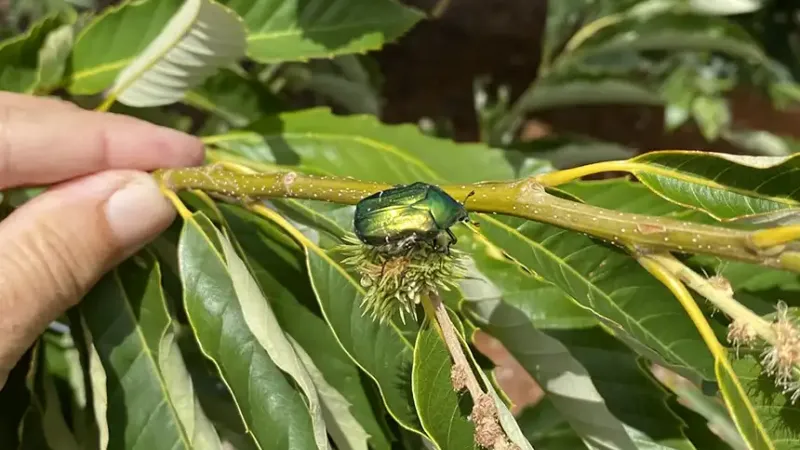
Gaštan sa odjakživa považoval za vetrom opelivý druh a opeľovanie gaštanov sa zdalo byť objasnené bez potreby ďalšej diskusie o tejto záležitosti. Prítomnosť rôzneho hmyzu na kvitnúcom strome gaštana sa nepovažovala za znak toho že by hmyz mohol zohrávať nejakú významnú úlohu v procese opeľovania samičích kvetov.
Prekvapivá úloha hmyzu pri opeľovaní gaštanov
Ale je to naozaj tak že sa gaštany opeľujú výlučne pomocou vetra a hmyz nepomáha pri zakladaní úrody? Ako sa teda gaštany vlastne opeľujú? Vetrom, hmyzom alebo oboma spôsobmi? Veľa otázok a málo presvedčivých odpovedí. Spôsob opeľovania gaštanov, dôležitého rodu lesných stromov z čeľade bukovitých, ktoré produkujú jedlé plody, zostával dlho nejasný. Mechanizmy zapojené do opeľovania gaštanov boli doteraz málo skúmané. V skutočnosti za vyriešením tejto otázky stáli nespokojní pestovatelia gaštanov, ktorí nízku úrodu pripisovali nedostatku vhodných kultivarov, ktoré by zabezpečili opeľovanie. Preto bola v roku 2018 vo Francúzsku spustená dizertačná práca medzi INRAE a Invenio (experimentálna stanica pre ovocný a zeleninový priemysel v Novom Akvitánsku) s cieľom preskúmať túto problematiku.
Prelomová výskumná práca odhaľujúca hlavný spôsob prenosu peľu
Dizertačná práca Clémenta Larueho, ktorá sa realizovala v rokoch 2018 až 2021 v sadoch spoločnosti Invenio v Douville mala za úlohu identifikovať hlavného prenášača peľu gaštanov. Experimenty preukázali jednoznačne dominantnú úlohu hmyzu. Je všeobecne známe že gaštanový sad slúži ako včelia pastva. Každý kto stál pod gaštanovým stromom v čase kvitnutia, si musel všimnúť množstvo včiel zbierajúcich peľ a nektár zo samčích kvetov. Avšak okrem včiel je možné na kvitnúcom gaštane pozorovať aj iné druhy hmyzu, a to najmä dva druhy chrobákov. Sú to Snehuľčík žltý - Rhagonycha fulva a Zlatoň obyčajný - Cetonia aurata. Včela sa vždy neomylne zaoberá len samčími kvetmi ktoré jej poskytujú peľ a nektár. Zriedkakedy preletí na samičí kvet. Ale chrobáky sa správajú inak. Neustále sa presúvajú zo samčích kvetov na samičie a naopak. Samičí kvet má podobné morfologické znaky ako samčí, ale neprodukuje ani peľ ani nektár. Pravdepodobne ide o adaptáciu gaštana so zámerom zmiasť hmyz a prilákať ho k blizne za účelom prenosu peľu.
Neveriaci pestovatelia gaštanov
Zistený fakt, že gaštan je entomofilný (hmyzom opeľovaný) druh, spočiatku po zverejnení výsledkov výskumu neboli pestovatelia gaštanov ochotní prijať. Výskumníci zo spoločnosti Biogeco preto rovnaké experimenty zopakovali na inom mieste, vo Villenave d'Ornon počas ďalších dvoch rokov, aby overili tieto výsledky. Tieto nové experimenty potvrdili, že hlavnú úlohu pri opeľovaní gaštanov zohráva hmyz.
Všetka táto práca nám teraz umožňuje prehodnotiť zakladanie gaštanových sadov a zaviesť opatrenia na zvýšenie biodiverzity s cieľom zvýšiť výnosy. To si vyžaduje zabezpečenie hojnosti voľne žijúceho opeľujúceho hmyzu výsadbou rôznych kultivarov gaštana produkujúcich peľ.
Zlatoň obyčajný - Cetonia aurata je dôležitým opeľovačom gaštana jedlého. Každá lokalita v blízkosti gaštanového sadu, kde sa v pôde vyskytujú pandravy Zlatoňa obyčajného, by mala byť chránená. Larvy zlatoňa sa živia prevažne odumretou organickou hmotou v pôde, a preto by sa nemali považovať za škodcu.
Odteraz je gaštan považovaný za popredný entomofilný druh stromu vo Francúzsku, čo predstavuje veľkú výzvu pre ochranu voľne žijúcich opeľovačov.












